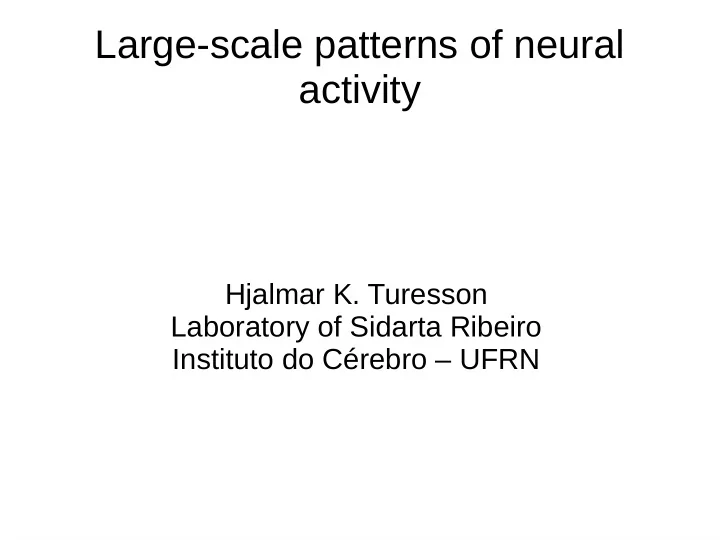

Large-scale patterns of neural activity Hjalmar K. Turesson Laboratory of Sidarta Ribeiro Instituto do Cérebro – UFRN
Scales of measurement Neural activity can be measured at multiple scales. What is the best scale for relating neural activity to behavior? ? ? ? ?
Goal: characterize large scale patterns ● Historically, large pattern patterns has often been postulated: – Cortical fields (Lashely, 1931) – Cell assemblies (Hebb, 1949) – Units of selection (Edelman, 1987) – Synfire chains (Abeles, 1991) – Coalitions of neurons (Crick & Koch, 2003) – Cortical songs (Ikegaya, 2004) ● Identify appropriate the spatial and temporal scale of measurement – The pattern that best predicts behavior on individual trials, given available models for analysis. ● Characterize basic features ● Make inferences of size, distribution and temporal dynamics of the neural population
Requirements on the method ● Global & regularly spaced sampling (as fMRI) ● Temporal & spatial resolution in the range relevant to neural events (as single unit and VSD recordings) ● Neurophysiologically interpretable – i.e. possible to relate the measures to more fine grained measures (single unit, patch clamp, …) ● Signal-to-noise good enough for prediction of single occurrences of behavior ● Rich & natural behavior – Don't assume reducibility
Methods available I Adapted from Sejnowski, Churchland and Movshon (2014)
Pruning the methods ● EEG, MEG, fMRI and PET are neurophysiologically ambiguous – EEG & MEG: large population synchrony, cell type and orientation, skull and scalp distortions (EEG only) – fMRI: Too low temporal (1-3 s) & spatial (5 million neurons in a voxel) resolution; measures blood flow and oxygenation level which do not have to be linked to changes in synaptic or spiking activity. – PET: Too low temporal (30-40 s) & spatial (> 5 million neurons in a voxel) ● Optical imaging (VSD & Ca +2 ) – To achieve a big field of view the entire region to image needs to be exposed and connected to a microscope; low SNR (requires averaging)
Methods available II Adapted from Sejnowski, Churchland and Movshon (2014)
Proposal: μECoG recordings in behaving marmosets ● Electrophysiology: subdural micro electro- corticography (μECoG) over the cortex ● Species : Common marmoset ( Callithrix jacchus ) ● Behavior : Anti-phonal calling Toda et al (2011)
Physiology: spatio-temporal extent ● Cortex is smooth and thus good for μECoG ● μECoG could cover most of a hemisphere Rubehn et al (2009)
Physiology: interpreting the signal ● Mainly a summation of EPSPs (excitatory post-synaptic potentials) of many cortical pyramidal cells. – Requires coherent activity and orientation of neurons ● Possible to combine with single unit recordings ● Spatial resolution around 0.5 mm – Probably corresponds to the spatial scale of the electrical field on the cortical surface ● However, higher resolution is possible, Khodagholy et al (2014) showed single unit recordings ● Surface area of a cortical hemisphere is around 500 mm 2 , thus requiring 2 000 electrodes for perfect coverage
Behavior: antiphonal calling (spontaneous replying to calls from other individuals) ● The brain has evolved and developed to support a certain behavioral repertoire. ● Sensori-motor behavior → cross-regional interactions → large scale patterns ● Spontaneous behavior don't require preparatory training → increased experimental turnover. ● Marmosets still call and reply reliably while physically constrained.
Data set ● Behavioral data Electrophysiological data ● Video from two cameras 250 – 1 000 channels – – 480 x 640 pixels per frame 1 – 5 kHz sample rate – – 30 & 200 fps 15 – 30 min per session – – 15 – 30 min per session 50 – 100 sessions – – 50 – 100 sessions 187.5 – 15 000 million data points 110 – 430 GB compressed video (0.75 – 60 GB) Sound from two microphones – 44.1 & 192 kHz sampling rates – 15 – 30 min per session – 50 – 100 sessions 24 – 96 GB raw sound
Data analysis ● Identify patterns of neural activity that are predictive of behavior without averaging over multiple repetitions. ● Characterize those patterns. ● Make inferences about the population of neurons giving rise to the observed patterns.
Thanks
Recommend
More recommend